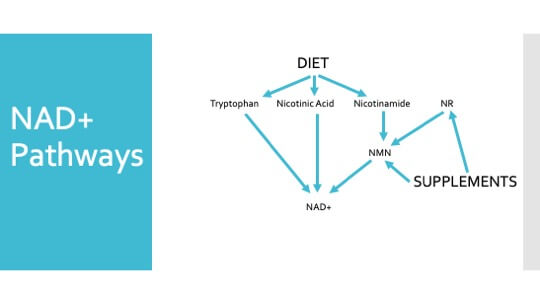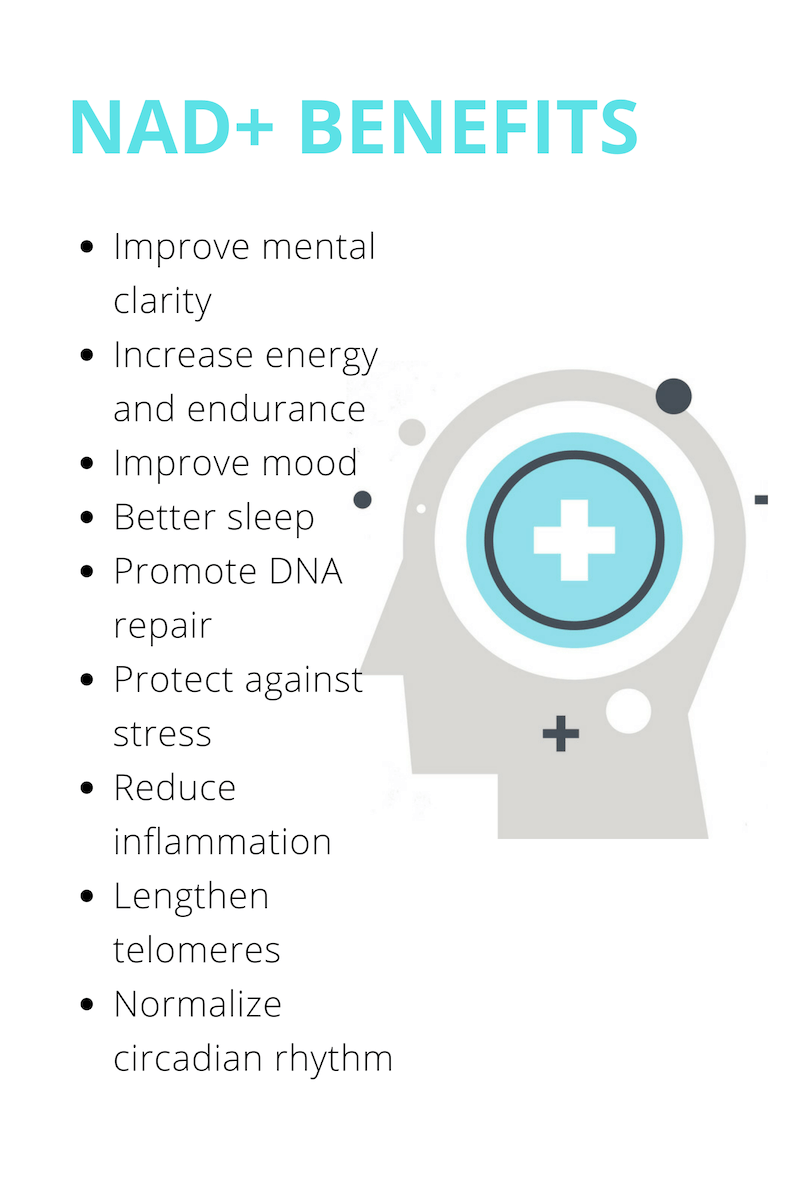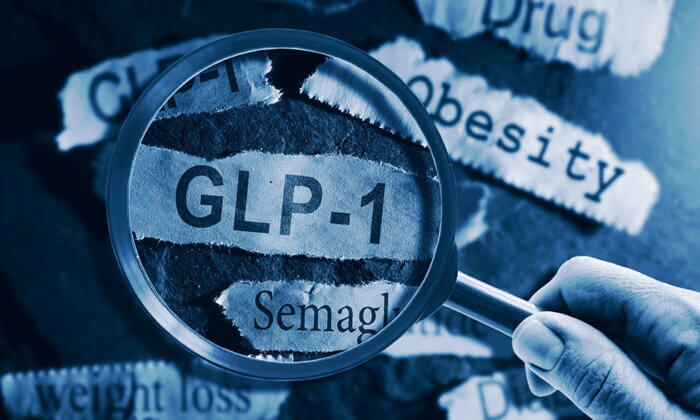How To Reach the 100-Year Life with NAD+
Can optimal NAD+ production, supported with supplements, boost metabolism enough to help you live a long healthy life?
| | Reading Time: 9 minutes

NAD+ (nicotinamide adenine dinucleotide) is an ancient molecule, a coenzyme necessary for life. This essential cofactor is involved in cell signaling pathways, redox reactions, and energy production in the cell. Signaling pathways are the ways cells communicate messages fundamental to life. Redox actions manage how cells utilize oxygen helping integrate mitochondrial function, the energy powerhouse of the cell. [1]
Our body produces NAD+ from two dietary nutrients: niacin (vitamin B3) and the amino acid, tryptophan. However, as we age, the body’s ability to make and recycle NAD+ declines, even if are not deficient in critical nutrients. It helps to get enough niacin and tryptophan in your diet, but research shows specialized supplements enhance NAD+ production. Will taking these supplements increase NAD+ production enough, beyond what an aging body can produce on its own, to help you reach a 100-year life?

There are two parts to NAD+ metabolism. The first is that NAD+ levels vary with age. Our body makes and recycles more than enough when we’re young. However, as we get older, NAD+ decline, and levels of the enzyme NAD+ nucleosidase (NADase) rise. The second part is CD38, a type of NADase that regulates NAD+ metabolism, accumulates. More NADase means less NAD+. And, too much CD38 is linked to chronic inflammation, and many diseases associated with aging including heart disease, asthma, diabetes, and cancer. CD38 can also interfere with mitochondrial function. Weakened mitochondria cannot produce sufficient energy to sustain life. The malaise and low energy experienced by CFS patients, and also associated with aging, is associated with mitochondrial insufficiency. Therefore, it makes sense that increasing NAD+ and inhibiting CD38 is the way to promote healthspan and longevity, and increase energy. [2]
This article explains how to get the most from NAD+ supplements and introduces NAD+ IV therapy. In Part II, I’ll discuss how to lower inflammation and inhibit CD38.
What’s The Difference Between NAD and NAD+?
NAD and NAD+ are scientific abbreviations used interchangeably for the coenzyme, nicotinamide adenine dinucleotide. Oral NAD supplements are NAD+ precursors, not the actual nicotinamide adenine dinucleotide molecule. In this report, I use NAD+ as the abbreviation of choice for the actual NAD+ molecule.
How To Choose An NAD+ Boosting Supplement
Nicotinamide riboside (NR) chloride is the most common NAD+ booster.
While researching NAD+ pathways, Charles Brenner Ph.D discovered NR in 2004. The California nutraceutical company, ChromaDex, produces NR sold as TRU NAIGEN®. Other NR supplements include NiaCel from Thorne Research and Basis by Elysium. The recommended NR dosages range from 100 to 300 mg per capsule taken once or twice daily.
Another choice is ß-nicotinamide mononucleotide (NMN). David Sinclair, Ph.D., the founder of Life Biosciences, a longevity startup in Cambridge, Massachusetts is the leading proponent of NMN. Marketed by ALIVE By Nature, and other companies, NMN increases NAD+ and activates SIRT1 pathways. Dr. Sinclair’s research supports the idea that NMN is more effective than NR supplements because it’s further along on the pathway to NAD+ and the digestive systems do not interfere with absorption nor does it get broken down by liver detoxification. NMN comes as 125 mg capsules or as a powder for sublingual use. [3]
Some researchers believe high dose NAD+ precursors interfere with methylation pathways. Instead of feeling better, you could have less energy. Lower doses may be better than higher amounts. Also, NR and NMN oral capsules may not make it into your bloodstream because the liver inhibits absorption. Powder or sublingual forms may be more efficient. [4]
There is scanty research and no agreement on the most effective dose for NAD boosters or about possible adverse effects. However, lower dosage and sublingual administration are emerging as the preferred way to take NAD boosters. This approach makes sense.
A third product is NADH, a sublingual supplement made by ENADA. George Birkmayer, M.D., Ph.D. pioneered the research in coenzyme 1 (CoE1) and developed a stabilized sublingual form, NADH (nicotinamide adenine dinucleotide hydride). The “H” stands for a high-energy hydrogen molecule. Dosages range from 5 to 20 mg. I recommend 5 mg of NADH daily and higher dosages for patients with chronic fatigue syndrome.
A German study in 2002[5] found 20 mg of NADH effective in reducing jet lag. I found that taking 20 mg of NADH one hour before arrival and another 20 mg on landing helps me stay alert and energized, the opposite of the out-of-sync feeling caused by jetlag.

For my patients, I recommend 125-250 mg of NR once daily or 30-50 mg of NMN powder. Resveratrol and pterostilbene are two compounds shown to slow aging with synergistic activity with NR or NMN, supporting both NAD+ levels and SIRT1 pathways. In addition to NR or NMN, I recommend taking 100-200 mg of coenzyme Q10 and 50 mg of pterostilbene daily.
The Anti-Aging Effects of NAD+
By the time we’re over 40 years, NAD+ declines. By 60, we can lose up to 50% of our NAD+. One study found after taking 300 mg NR for eight weeks, NAD+ levels were up by 50%. Keep in mind that these results are from animal studies, not humans. No blood test is available yet to measure your NAD+ levels. [6]
Getting your NAD+ level higher with supplements may improve sirtuin pathways. We know of seven sirtuins (SIRT 1-7) pathways, and all depend on NAD+. Sirtuins are energy-sensing regulators playing critical roles in aging and chronic diseases. NAD+ supplements may support the SIRT 1 pathway to delay the onset of aging.
Other anti-aging benefits include improvement in brain and nervous system functions, better liver function, heart-protective benefits, immune enhancement, kidney protective effects, better insulin secretion from the pancreas and increased insulin sensitivity, improved weight management, and reduced cancer risk. But, I find two benefits of most interest for my patients: (1) restoring telomere length and, (2) delaying accelerated aging.[7]
NAD+ IV Infusion Therapy
In the late-1990s, I was a frequent visitor at the Hitt Wellness Center in Tijuana, Mexico. William (Bil) Hitt, M.D., Ph.D.,[8] was known to treat alcoholism and drug addiction with intravenous NAD+ and a cocktail of amino acids. At the time, I had little interest in this treatment because I was there to observe another therapy.
Dr. Hitt also treated chronic viruses with IV ozone and urine injections. In the time before effective antiviral drugs for HIV and HCV, some physicians including Bill Hitt relied on experimental treatments like ozone. At the time, I was working on my book, VIRAL IMMUNITY. Dr. Hitt’s IV ozone machine was of German design used for major autohemotherapy, a procedure where the patient’s blood is withdrawn, ozonated, and immediately reintroduced into the patient.
However, but I spoke with many of his NAD+ patients who reported feeling lighter and clearer-minded after their daily IV sessions. I didn’t realize it then, but twenty years later I introduced NAD+ IV therapy at the DaSilva Institute where I practice functional therapies.
With its ability to bypass the intestines and liver, IV infusion of vitamins and minerals may seem like the latest craze, but a John’s Hopkins physician developed the famous Myers Cocktail almost 60 years ago, and NAD+ IV infusions were first used in the 1960s.
NAD+ IV anti-aging infusions are a favorite in markets like Miami, New York, Phoenix, Sarasota, and in California. Because NAD+ IV infusions work so well to prevent aging, IV infusions are on the rise for other conditions like autoimmune disorders, chronic fatigue, chronic pain, and for increased energy or physical performance.
I’d been prescribing NAD+ for my patients in oral form, but with the revival of NAD+ in IV infusion therapy, I knew our patients would benefit more if we offered it intravenously. When you take NAD+ supplements, you rarely feel a boost, but if you get it through an IV infusion patients experience a lift in mood and wellbeing. With myself, and our patients who receive NAD+ IVs, the results are immediate. Most are more mentally alert, yet relaxed; energized and less tired, but not wired.
NAD+ for IV infusion uses synthetic ß-Nicotinamide adenine dinucleotide. It’s considered safe when administered slowly over 4-6 hours. Adverse reactions include stomach cramping and headache when the drip is too fast. Average dosages range from 250 to 750 mg, with a safe range not exceeding 1,500 mg per day. NAD+ IV treatment protocols vary depending on your specific health needs.

Lifestyle & Dietary Support for Optimal NAD+
Nicotinic acid, nicotinamide, and tryptophan are NAD+ precursors. Nicotinic acid and nicotinamide are both forms of niacin (Vitamin B3). The daily recommended dose of niacin is 16 mg of men and 14 mg for women. Niacin is found in yeast and mushrooms, meat, liver, poultry, tuna and salmon, anchovies, cereal grains, legumes like lentils, and seeds like from sunflowers. Green leafy vegetables have little niacin. To assure adequate dietary niacin, vegans need to eat seeds and nuts rich in niacin. Multivitamins provide up to 20 mg of niacin or niacinamide.
Pharmacological dosages for niacin range as high as 3,000 mg daily. Taking high dosages of niacin helps lower LDL cholesterol and raise HDL. It can also reduce the risk of skin cancer and prevent or manage diabetes. However, too much niacin can cause uncomfortable flushing. And, more niacin doesn’t make for higher NAD+ levels. Nicotinamide, a form on vitamin B3 that doesn’t cause flushing, helps support NAD+ metabolism, but high doses don’t directly boost NAD+ levels. The same applies to tryptophan. You need enough in your diet to support NAD+, but taking more doesn’t raise levels.
Besides oral, sublingual, and IV methods you can also boost NAD+ with calorie restriction called a fasting mimicking diet. The fasting state or limiting calories stimulates an increase in protective proteins called sirtuins. Sirtuins help to modulate metabolism and makes the cells less prone to oxidative stress. These sirtuins depend on NAD+. There is a substantial amount of research on sirtuins to help fight chronic diseases and the overall aging process.
During times of famine or fasting, our ancestors’ molecules were stimulated, triggered by calorie restriction, increasing NAD+ energy production providing the edge necessary for survival. Today, people in the West rarely experience famine, so their NAD+ levels decline by the time they reach 40 years. However, those who practice intermittent fasting experience an energy high from NAD+ bursts, though a shadow of what our ancestor experienced. Another way to boost NAD+ is by eating the high-fat, low-carbohydrate ketogenic diet. Researchers found that NAD+ in the brain and reduced inflammation. [9]
Reaching The 100-Year Life With Optimal NAD+
There is a resurgence of interest in NAD+ including multiple trials in humans for various disorders like Alzheimer’s disease and neurodegenerative diseases like Parkinson’s. Other studies on the effects of NAD+ on alcohol withdrawal, schizophrenia, and depression are ongoing. But the real interest is in its ability to slow aging.
During aging, NAD+ decreases, our health deteriorates, chronic diseases appear. NAD+ supplements can restore energy metabolism, but can it effectively slow aging? We don’t know yet, but the research and clinical results are promising.
I’ve used NAD+ for my patients with Parkinson’s disease and found their speech and mobility improve; in some cases, the results are impressive. However, I don’t see NAD+ as a cure, but a new tool for better management of the symptoms of Parkinson’s and other neurocognitive disorders. [10]
NAD+ along with telomeres regulate how quickly your cells age, boosting supplements can stabilize telomeres. NAD+ promotes cellular metabolism including cellular repair, improves nervous system function, reduces pain, stimulates arterial healing, improves cognitive function, and restores muscular conditions including prevention of sarcopenia.
For those facing illness, chronic disease, or other adverse conditions associated with aging, getting NAD+ infusions can reverse DNA damage, increase antioxidant intake, modulate inflammation, and slow neurodegenerative changes.
People are living longer, but that doesn’t mean healthier. Though healthy older adults have enough NAD+ in their cells, it’s still less than our younger selves. Supplementing with NAD is fundamental for healthy aging for all adults over 50 years who want to reach the 100-year life.
SUMMARY
Be proactive about aging, take NAD+ supplements and get regular NAD+ infusions to increase the healthspan and promote wellness as you age. NAD+ is a life-extending protocol that offers better health during aging. If you want to age well and have less chronic conditions, be independent and reach 100 years or more without the chronic degenerative disease, consider NAD+ infusions along with other healthy lifestyle changes including plant-based diet and exercise.
- Assure adequate dietary and supplemental sources for niacin, nicotinamide, and tryptophan
- Take resveratrol 100 mg (trans-resveratrol), pterostilbene 50 mg (methylated resveratrol), Coenzyme Q10 200 mg (ubiquinone)
- Take nicotinamide mononucleotide (NMN) 125-250 mg daily or nicotinamide riboside (NR) 300 mg daily. For those with concerns about abnormal DNA methylation, take NMN powder at a lower dose of 30-50 mg daily.
- For an NAD+ boost, take NADH 5 mg sublingual tablets. To prevent jet lag, take NADH 20 mg.
- To reach optimal NAD+ levels get IV ß-Nicotinamide adenine dinucleotide infusion weekly or monthly.
References:
[1] Rajman, L., Chwalek, K., & Sinclair, D. A. (2018). Therapeutic Potential of NAD-Boosting Molecules: The In Vivo Evidence. Cell metabolism, 27(3), 529–547. doi:10.1016/j.cmet.2018.02.011
[2] Chini E. N. (2009). CD38 as a regulator of cellular NAD: a novel potential pharmacological target for metabolic conditions. Current pharmaceutical design, 15(1), 57–63.
[3] Michan, S., & Sinclair, D. (2007). Sirtuins in mammals: insights into their biological function. The Biochemical journal, 404(1), 1–13. doi:10.1042/BJ20070140
[4] Cantó, C., Menzies, K. J., & Auwerx, J. (2015). NAD(+) Metabolism and the Control of Energy Homeostasis: A Balancing Act between Mitochondria and the Nucleus. Cell metabolism, 22(1), 31–53. doi:10.1016/j.cmet.2015.05.023
[5] Birkmayer GD1, Kay GG, Vürre E. (2002). Stabilized NADH (ENADA) improves jet lag-induced cognitive performance deficit. Wien Med Wochenschr. 2002;152(17-18):450-4
[6] Cantó, C., & Auwerx, J. (2011). Targeting sirtuin 1 to improve metabolism: all you need is NAD(+)?. Pharmacological reviews, 64(1), 166–187. doi:10.1124/pr.110.003905
[7] Rajman, L., Chwalek, K., & Sinclair, D. A. (2018). Therapeutic Potential of NAD-Boosting Molecules: The In Vivo Evidence. Cell metabolism, 27(3), 529–547. doi:10.1016/j.cmet.2018.02.011
[8] The Hitt Wellness Center continues under the Jane Hitt in Tijuana, Mexico.
[9] Elamin, M., Ruskin, D. N., Masino, S. A., & Sacchetti, P. (2017). Ketone-Based Metabolic Therapy: Is Increased NAD+ a Primary Mechanism?. Frontiers in molecular neuroscience, 10, 377. doi:10.3389/fnmol.2017.00377
[10] Błaszczyk J. W. (2018). The Emerging Role of Energy Metabolism and Neuroprotective Strategies in Parkinson’s Disease. Frontiers in aging neuroscience, 10, 301. doi:10.3389/fnagi.2018.00301


